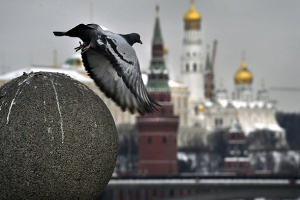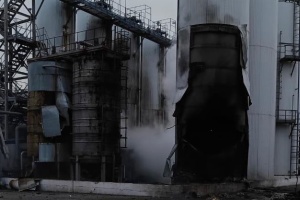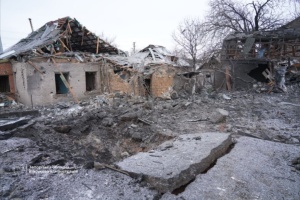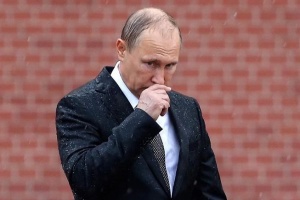
10 facts about Russian-Ukrainian war
1. Russian aggression against Ukraine has lasted not two years, but a whole decade (and even longer)
Russia attacked Ukraine not in February 2022, but eight years earlier: in February 2014. It all started with Crimea. The fact that there were no large-scale hostilities should not mislead anyone. Hybrid aggression is still aggression.
The date February 20, 2014, is inscribed on the campaign medal of the Russian Ministry of Defence “For the Return of Crimea.” This day is defined as the beginning of the armed Russian aggression in the Statement of the Verkhovna Rada of Ukraine On Repelling the Armed Aggression of the Russian Federation and Overcoming Its Consequences. In Crimea, the Armed Forces of Ukraine suffered the first human losses from the occupiers. Warrant officer Serhii Kokurin was killed on March 18.
The next stage of the aggression was the hybrid occupation of a number of districts of Luhansk and Donetsk oblasts in the spring of 2014. As in Crimea, not only local fighters, but also regular Russian troops took part in the aggression in the Donbas. In fact, the so-called 1st and 2nd corps of the People’s Militia of the DPR and LPR were also part of the armed forces of Russia.
The third stage of Russian aggression was a full-scale invasion, which began on February 24, 2022. However, Russia made its first practical attempt to violate the territorial integrity of Ukraine back in 2003, when it tried to seize the island of Tuzla in the Kerch Strait.
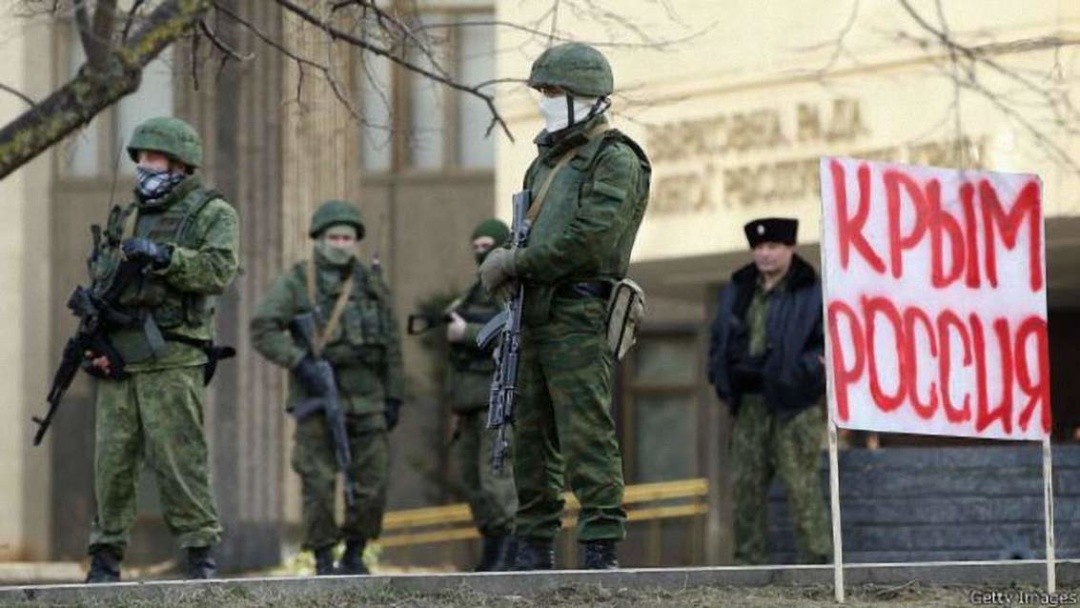
Russian troops in Crimea / Source: BBC-Ukraine
2. “Coup d’état on the Maidan” as a fictional casus belli
Commenting on the causes of the war, Russian propaganda keeps mentioning the so-called “coup d’état,” that is, the escape of President Yanukovych after the shootings of participants in the Revolution of Dignity in Kyiv.
First of all, there was no “coup d’état” in Ukraine. At the time of Yanukovych’s self-removal (and his transformation into a puppet of the Putin regime), the legitimacy and heredity of the authorities were maintained by the Ukrainian parliament. In the same 2014, early presidential and parliamentary elections were announced. If Yanukovych’s victors had been usurpers, it is unlikely that they would have let go of the power transferred to the new team so easily. In 2019, the power in Ukraine was updated again. Despite all its propaganda rhetoric, Moscow has never officially questioned the legitimacy of Ukraine’s authorities after 2014.
Secondly, the internal political processes in Ukraine did not give Russia any legal grounds for intervention. Moscow’s military intervention was not sanctioned by the UN, it was not based on any interstate agreements between Ukraine and the Russian Federation. The validity of the “invitation of Russian troops to Ukraine” signed by Yanukovych, which was demonstrated by Russia’s representative to the UN Churkin, was challenged even by the lawyers of the fugitive president in a Ukrainian court.
3. “Russian Spring”: occupation under the smoke screen of fake stories
Until 2022, Russia hid and denied in every way that it was a party to the armed conflict with Ukraine. Therefore, this stage of the war is usually called “hybrid,” in the sense of disguised as something different from Russian aggression.
The Kremlin has long and stubbornly called its soldiers in Crimea “local self-defence units,” which purchased military equipment in army surplus stores. The overthrow of the legitimate institutions of power in Luhansk and Donetsk oblasts took place under the slogans of local separatism, but the leading role in the events of the spring of 2014 was played by Russian special services and mercenaries. For example, the seizure of Sloviansk in April 2014 was carried out by a sabotage group led by Igor Girkin, an employee of the Russian Federal Security Service, who later became the “Minister of Defence of the DPR.”
Russian propaganda all this time talked about the “civil war in Ukraine,” “the popular uprising in the Donbas,” etc. When the servicemen of the 98th Guards Airborne Division of the Russian Armed Forces were taken prisoner in August 2014, Putin said that “they just got lost.” Similarly, in February 2015, tankers from Buryatia “got lost” near Debaltseve. An even higher number of Russian servicemen in the Donbas were recorded in the investigations by InformNapalm and other teams of observers.
Without Russian organizational, personnel, and resource support, the regimes of the so-called “DPR” and “LPR” simply could not exist.
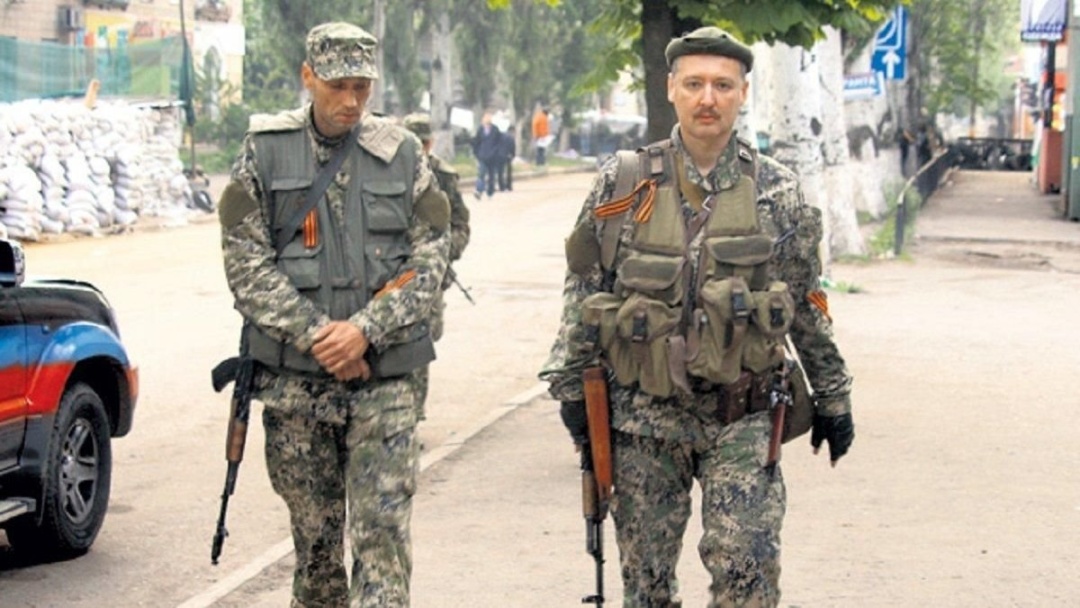
Igor Girkin (right) in Donetsk, 2014. Source: Twitter
4. Russia’s goal is not “peacekeeping” and not the return of “historical territories,” but the complete subjugation of Ukraine or its destruction.
Putin’s statements that the attack on Ukraine was necessary to “protect” the residents of the Donbas, or that Russia was simply seeking to return its “historical territories” are not true.
The fighting in Luhansk and Donetsk oblasts began precisely as a result of the Russian invasion in 2014. Before that, nothing had threatened the lives of Ukrainian citizens. The more the Kremlin intervenes to “protect,” the more civilians die.
The concept of “historical territories” is generally null and void, in contrast to the internationally recognized state borders of Ukraine, which Moscow seeks to arbitrarily change in accordance with its own imperial ambitions. The “historical nature” of certain territories is the result of the human imagination. Yesterday, the “historical lands” according to Putin included Crimea; today, it is Zaporizhzhia; tomorrow, it will be Kyiv. With such an argument, there is no reason to hope that Russia will ever voluntarily stop its expansion.
The Kremlin needed “Novorossiya” and “people’s republics” only to impose a confederal system on Ukraine, when through a controlled subject of the “confederation,” it was possible to determine the political course of the entire country divided in this way. However, in 2022, Moscow’s patience ran out. Nowadays, Putin is waging a war to destroy Ukrainian statehood and erase the Ukrainian national identity. Neither professional propagandists nor the political establishment, such as Deputy Chairman of the Security Council of the Russian Federation Medvedev and even the Kremlin dictator himself, hide this goal.
5. It was Russia that destroyed the mechanisms of a political settlement and disrupted the Minsk agreements
Since the beginning of the Russian invasion, Ukraine has been looking for political ways to resolve the conflict to avoid escalation and human casualties. Hoping for diplomacy, Kyiv did not start hostilities in Crimea in the spring of 2014.
During the anti-terrorist operation, Ukraine repeatedly initiated a ceasefire. In September 2014, the Minsk Protocol was signed: an agreement that was supposed to put an end to the bloodshed. Russia violated Minsk-1 when it resumed fighting for Donetsk airport and Debaltseve. As a result, in February 2015, the Minsk-2 agreement appeared.
This gave rise to a long and complex negotiation process involving the OSCE, as well as the leaders of Germany and France. However, contrary to the Minsk agreements, on February 21, 2022, Putin recognizes the independence of the so-called “DPR” and “LPR.” Less than a week before Russia’s full-scale invasion of Ukraine, Michael Carpenter, the U.S. Permanent Representative to the OSCE, was forced to state that “Russia has yet to fully implement a single commitment under the Minsk Package of Measures. It has not implemented an immediate and comprehensive ceasefire, it has not withdrawn heavy weapons, and it has not allowed access for effective monitoring and verification of these steps. Most importantly, it has not disarmed illegal armed groups and has not returned control of the Ukrainian side of the international border to Ukraine.”
As evidenced by subsequent events, Russia used Ukraine’s goodwill against it: while Moscow’s representatives were imitating the negotiation process in Minsk, Russian generals were planning a “blitzkrieg.”
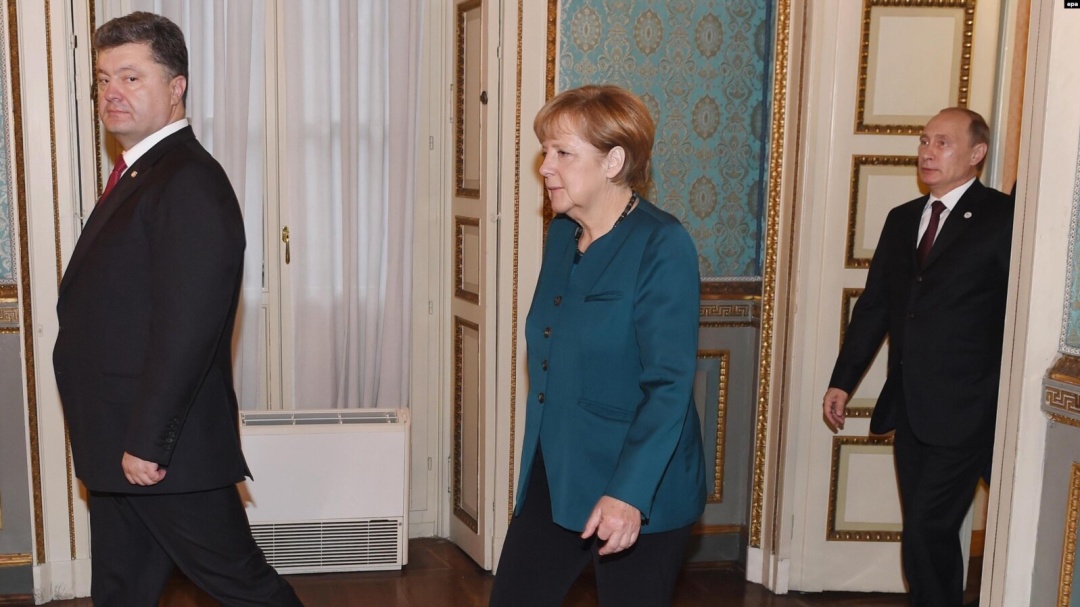
Angela Merkel, Petro Poroshenko and Vladimir Putin. Photo: EPA
6. “Eight years of bombing the Donbas”: a hypocritical myth as a pretext for a full-scale invasion
The key myth of the Kremlin to justify the full-scale invasion is that it is a “retribution” for the fact that the Ukrainian army has been shelling civilians in the Donbas for 8 years and has not been punished. For each accusation of another act of Russian barbarism in 2022, propaganda answered with a rhetorical question: “Where have you been these eight years?”
This is typical Putin’s hypocrisy because it was Russia that brought the war to Donetsk and Luhansk oblasts; before the spring of 2014, Donbas had led an ordinary peaceful life. Still, the horror that the “Russian spring” brought to Donetsk and Luhansk oblasts is not commensurate with the tragedy of the full-scale invasion.
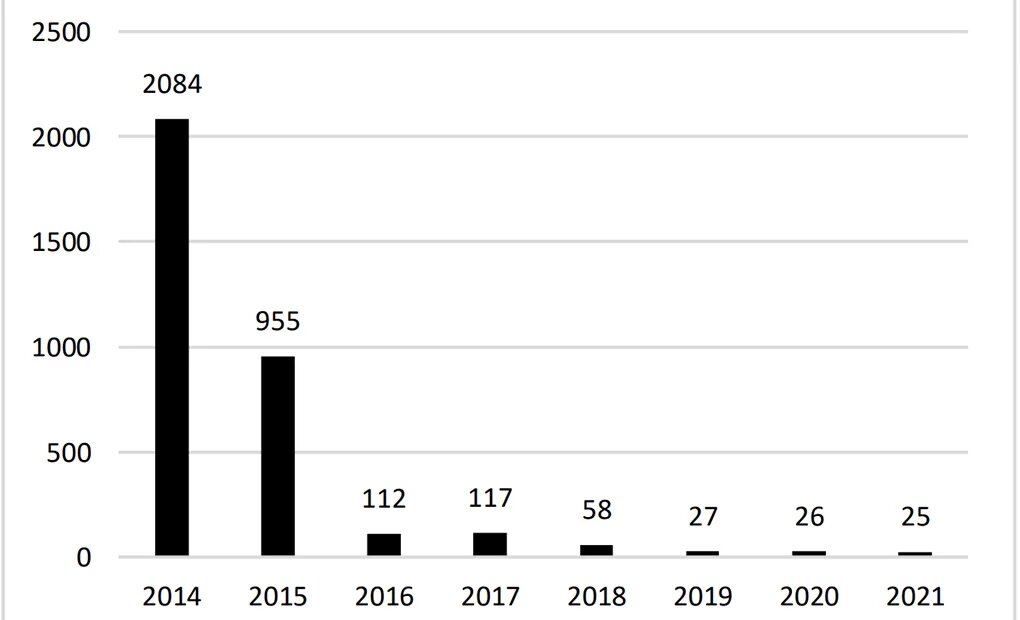
Statistics from the Office of the United Nations High Commissioner for Human Rights show that the number of civilian casualties in Donbas gradually decreased until 2022
After the battles for Debaltseve in the winter of 2015 died down, the conflict reached a “frozen” stage and the number of victims fell sharply. Thus, violations of the ceasefire regime were periodically recorded, but it would be an absolute lie to record all these cases as the fault of the Ukrainian side. In violation of the Minsk agreements, Russia regularly resorted to artillery and mortar shelling, ATO/JFO participants were killed by sniper fire and enemy subversive groups. However, even the front-line occupied Donetsk and Luhansk did not experience massive bombing and systematic destruction of city districts.
Since the beginning of the full-scale invasion in the Donbas, the Russian army has been practising the most destructive and even genocidal methods of warfare. Such cities of Donetsk and Luhansk oblasts as Mariupol, Popasna, Sievierodonetsk, Lysychansk, Avdiivka were effectively razed to the ground.
7. The world and Ukraine made efforts to prevent Putin from launching a full-scale attack
Since the beginning of the full-scale invasion, Moscow has been generating a narrative, according to which Russia was “forced” to start a war to protect its “existential interests.” This is a hypocritical lie: back in the second half of 2021, the world was trying to convince Putin to abandon his criminal intentions. The United States tried to maintain constructive communication with Russia, Berlin voiced calls for de-escalation, Paris offered to think about a new format of dialogue, etc. Kyiv also did everything possible to avoid the war: back in 2019, Ukraine agreed to the disengagement of troops in several areas of the demarcation line in the Donbas. Volodymyr Zelenskyy himself ran for the 2019 presidential election including under the slogans of establishing peace. However, all these efforts were shattered by Putin’s fanatical desire to realize his own imperial ambitions.
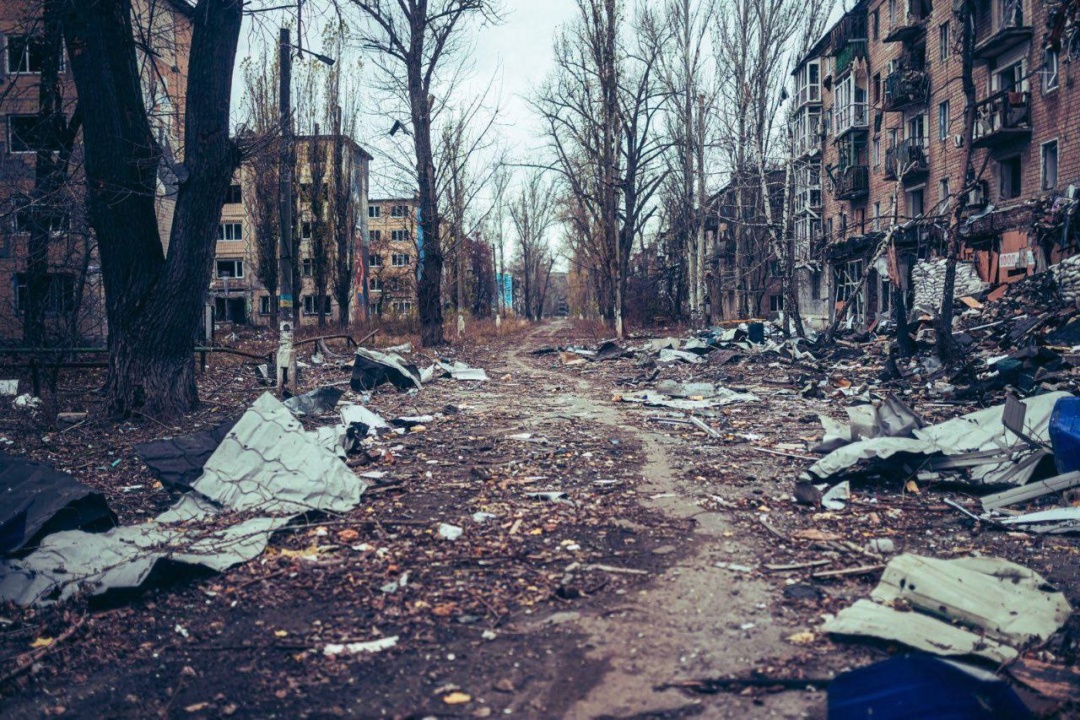
Destroyed Avdiivka, November 2023. Source: Oleksandr Tarnavskyi
8. Suicide instead of “blitzkrieg”
The Russian plan for the lightning-fast seizure of Ukraine totally failed back in March 2022, when the Ukrainian Defence Forces prevented the occupation of Kyiv, as well as drove out Russian troops from Chernihiv and Sumy oblasts. But instead of abandoning further encroachments on Ukraine’s sovereignty, Moscow launched a bloody and protracted war of attrition.
Now Putin is trying to avoid responsibility for his previous crimes by committing new ones—even more serious ones. Meanwhile, official propaganda deceptively presents Putin’s special military operation as Russia’s “existential struggle” or even as a global confrontation with the “satanic West.” In fact, this war is meaningless and destructive for Russia itself. According to the General Staff of the Armed Forces of Ukraine, as of February 19, the losses of the Russian army have already exceeded 400,000 people. But it is not only about the death of people whom Moscow is pushing for a criminal war. The final transformation of Russia into a dictatorship, which occurred after the beginning of the full-scale invasion, has already provoked mass emigration, the volume of which may amount to 1.3 million people.
The militarization of economic, cultural, and political life, as well as growing international isolation, are all signs that Russia is deliberately turning itself into an exile state, incapable of productive and mutually beneficial cooperation with the world. This, and not the mythical “conspiracy of the Anglo-Saxons,” which Putin claims, puts an end to the future of the Russian Federation.
9. Ukraine is able to resist effectively
The failure of Putin’s “blitzkrieg” in the spring of 2022 was neither a “miracle” nor a surprise. Back in 2014, the forces involved in the Anti-Terrorist Operation liberated large areas of Luhansk and Donetsk oblasts, including 18 cities, such as Sloviansk, Mariupol, Bakhmut, Avdiivka, Rubizhne, Sievierodonetsk, Lysychansk, Shchastia, etc. Thus, Ukraine undermined the plan of hybrid occupation of the Donbas. Moreover, thanks to the actions of law enforcement officers and the resistance of civil society, the project of occupation of a number of eastern and southern regions of Ukraine (the so-called “Novorossiya from Kharkiv to Odesa”), which was nurtured in Moscow, was destroyed. Finally, before the full-scale invasion, only a third of the total territory of Donetsk and Luhansk oblasts remained under the control of Russia.
During the full-scale war, Ukraine proved again that it could effectively resist the aggressor. In 2022, Russian troops were expelled from the central and northern regions of Ukraine. In September, the Defence Forces carried out a successful counter-offensive in the east, liberating most of Kharkiv Oblast. In November, Kherson, the only regional centre that the Russians managed to occupy after February 24, 2022, was liberated in the south. Subsequently, a bridgehead was established on the left bank of the Dnipro, which is of strategic importance.
Particular attention should be paid to the achievements of Ukraine in the maritime theatre of military operations. In addition to the liberation of Snake Island and drilling platforms, Ukraine inflicted heavy losses on the Black Sea Fleet of the Russian Federation. The sinking of the missile cruiser Moskva in April 2022 was only the beginning: today, the number of destroyed Russian warships is approaching 30.
Destruction of Caesar Kunikov, a large landing ship of the Black Sea Fleet of the Russian Federation, on February 14, 2024. Source: Main Directorate of Intelligence
10. Putin’s “goodwill gestures” are not an invitation to negotiations, but a deception
In recent months, Moscow has repeatedly announced its readiness to start the negotiation process. However, there is currently no real evidence that such statements are anything more than an element of the information warfare against Ukraine and its international partners.
As evidenced by the events of 2014-2021, Russia can use diplomatic pauses to build up its own forces for further armed escalation. Demonstrative “peace-loving gestures” are also an attempt to sow doubt among Kyiv’s allies: maybe it is Ukraine, not Russia, that does not seek peace? Is it worth continuing to arm the Ukrainians if the Russians already want to negotiate?
However, since the beginning of the full-scale invasion, Moscow has never demonstrated its readiness for real compromises. The Kremlin simply ignored Kyiv’s early warnings about the impossibility of further negotiations with Putin in the event of the annexation of new territories of Ukraine. Now Russia constantly insists on “considering new territorial realities,” which means the requirement to recognize illegal annexations, which do not cease.
All this time, Russia has been purposefully waging a genocidal war against Ukraine. The war crimes committed by Russian troops in Bucha, Borodianka, Mariupol, Izium, and many other cities of Ukraine shocked the whole world. In July 2022, Russia shelled a prison in the village of Olenivka, Donetsk Oblast, thus committing a mass execution of Ukrainian prisoners. In the winter of 2022-2023, Russia tried to destroy Ukraine’s energy system and cause a humanitarian catastrophe that would have killed millions of civilians. In June 2023, Russian troops blew up the Kakhovka HPP, which provoked a large-scale environmental disaster.
The list of Russian crimes is not exhaustive, but it is already obvious: Moscow does not want peace, but uses terror to force capitulation, which would be a catastrophe for the Ukrainian people and would mean the collapse of the existing international order.
Center for Strategic Communication and Information Security
First photo: Ukrainian defender / Source: 93rd Mechanized Brigade

